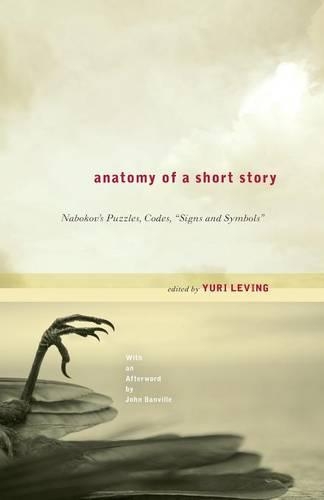
Anatomy of a Short Story: Nabokov's Puzzles, Codes, "Signs and Symbols"
(Paperback)
Available Formats
Publishing Details
Anatomy of a Short Story: Nabokov's Puzzles, Codes, "Signs and Symbols"
By (Author) Professor Yuri Leving
Continuum Publishing Corporation
Continuum Publishing Corporation
9th August 2012
United States
Classifications
Tertiary Education
Non Fiction
Literary studies: c 1900 to c 2000
813.54
Physical Properties
Paperback
432
Width 138mm, Height 216mm
608g
Description
Since its first publication in 1948, one of Vladimir Nabokov's shortest short stories, "Signs and Symbols," has generated perhaps more interpretations and critical appraisal than any other that he wrote. It has been called "one of the greatest short stories ever written" and "a triumph of economy and force, minute realism and shimmering mystery" (Brian Boyd, Vladimir Nabokov: The American Years). Anatomy of a Short Story contains: the full text of "Signs and Symbols," line numbered and referenced throughout correspondence about the story, most of it never before published, between Nabokov and the editor of The New Yorker, where the story was first published 33 essays of literary criticism, bringing together classic essays and new interpretations a round-table discussion in which a screenwriter, a theater scholar, a mathematician, a psychiatrist, and a literary scholar bring their perspectives to bear on "Signs and Symbols" Anatomy of a Short Story illuminates the ways in which we interpret fiction, and the short story in particular.
Reviews
"Signs or symbols, satire or realism, closure or no closure, soluble or insoluble riddle Responding to the challenge presented by this enigmatic short story, aware that Nabokov did not believe in what he called the symbolism racket', the contributors to this excellent collection of articles have mobilized a wide spectrum of hermeneutics. Convinced, with John V. Hagopian, that no legitimate artist produces randomness', they gamely attempted to quiz the author's elusive figure, developing a brand of creative paranoia, yet never claiming, except in one case (Dolinin), to play the part of the oracle. The result is a challenging exercise of Practical Criticism' which touches upon the bone and structure of Nabokov's work." -- Maurice Couturier, Professor Emeritus, University of Nice, France, writer and translator, editor-in-chief of the Pliade edtion of Nabokov's novels.
The critical anthology is called Anatomy of a Short Story not accidentally. What we have here is not a marauding or exhuming of a senseless body, but a study of a living artistic organism. Collective dissection presupposes using various methods, diversified optics and descriptive procedures Yuri Levings own array of scholarly interests turns Anatomy from a potentially dull registrars compendium into a collection of peculiar and often unexpected utterances about Nabokovs text This book will prove handy to anyone interested both in Nabokov as well as in studying literary texts in general. -- Mikhail Efimov * LiteraruS - Literaturnoe Slovo *
Levings collection is a huge achievement, and its scope is impressive, with thirty articles in total, mostly previously published, spanning over thirty years of scholarship. This is the books foremost triumph and as such positions itself alongside the Garland Companion to Vladimir Nabokov, is a must for anyone interested in Nabokovs story and, more generally, the historical progression of Nabokov studies. * Matthew Apperley, UCL SSEES, The Slavonic and East European Review (Vol. 92, No. 2, April 2014) *
Following the success of his Keys to the Gift: A Guide to Vladimir Nabokovs Novel (Boston, MA, 2011) Levings latest foray into Nabokov studies comes at a crucial moment in the field. Little has been published on Nabokov in recent years that matches the powerhouse of scholarship of the past; maybe the time is right to address where we are with Nabokov and, potentially, where we are going. In this regard Levings collection is a huge achievement, and its scope is impressive, with thirty articles in total, mostly previously published, spanning over thirty years of scholarship. This is the books foremost triumph and as such positions itself alongside the Garland Companion to Vladimir Nabokov (New York, 1995), is a must for anyone interested in Nabokovs story and, more generally, the historical progression of Nabokov studies. -- Matthew Apperley, UCL SSEES, UK * Slavonic & East European Review *
Author Bio
Yuri Leving is Professor and Chair in the Department of Russian Studies, Dalhousie University, Canada. He is the author of three books, including Train Station - Garage - Hangar. Vladimir Nabokov and the Poetics of Russian Urbanism (2004) and Keys to The Gift. A Guide to V. Nabokov's Novel (2011), and has also co-edited three volumes, including Empire N: Nabokov and His Heirs (2006) and Goalkeeper: The Nabokov Almanac (2010). Leving has published over seventy scholarly articles on various aspects of Russian and comparative literature. He served as a commentator on the first authorized Russian edition of The Collected Works of Vladimir Nabokov in five volumes (1999-2001), and was the curator for the exhibition "Nabokov's Lolita: 1955-2005" in Washington, D.C., which celebrated the 50th anniversary of the publication of Lolita.
